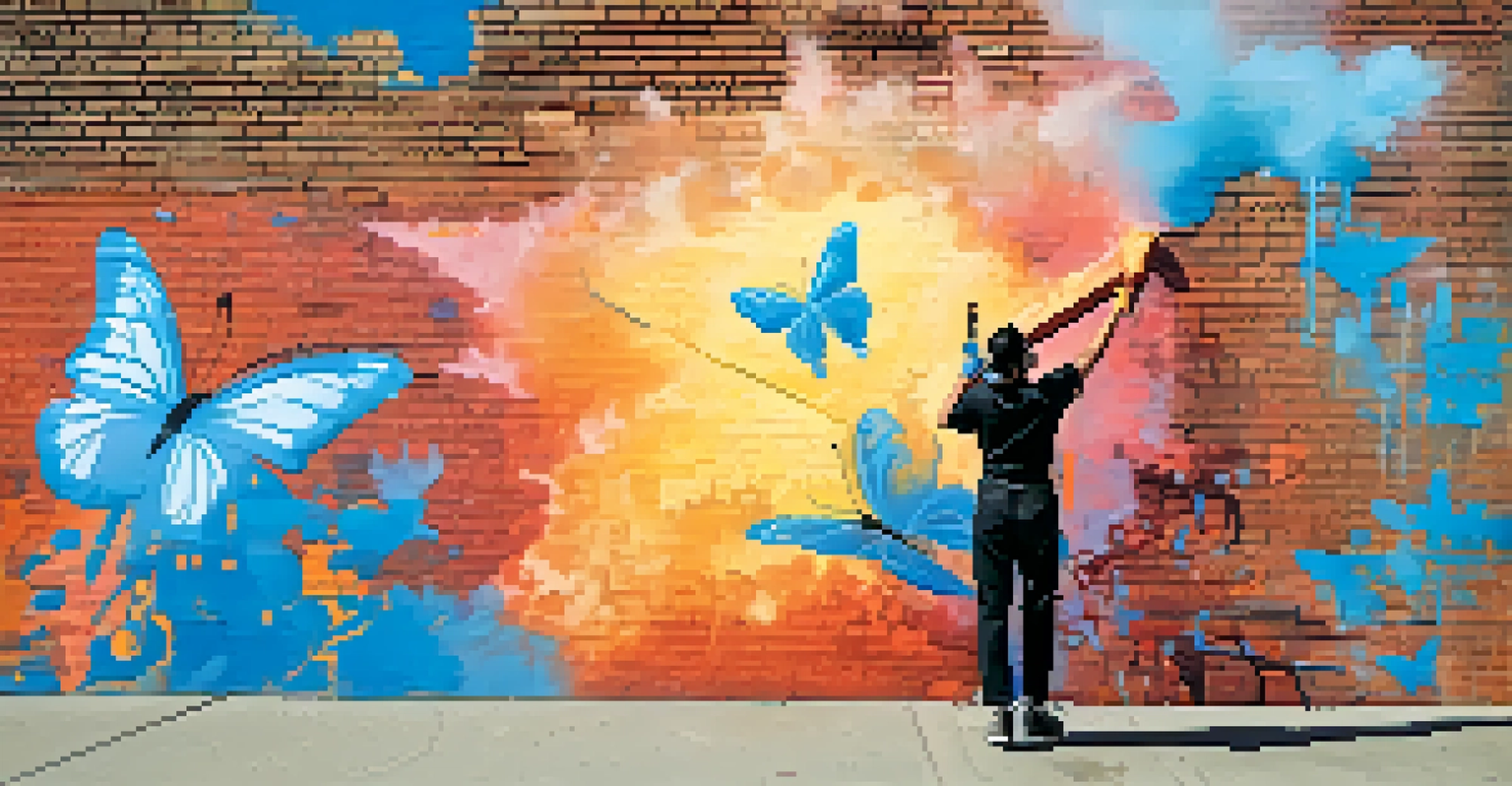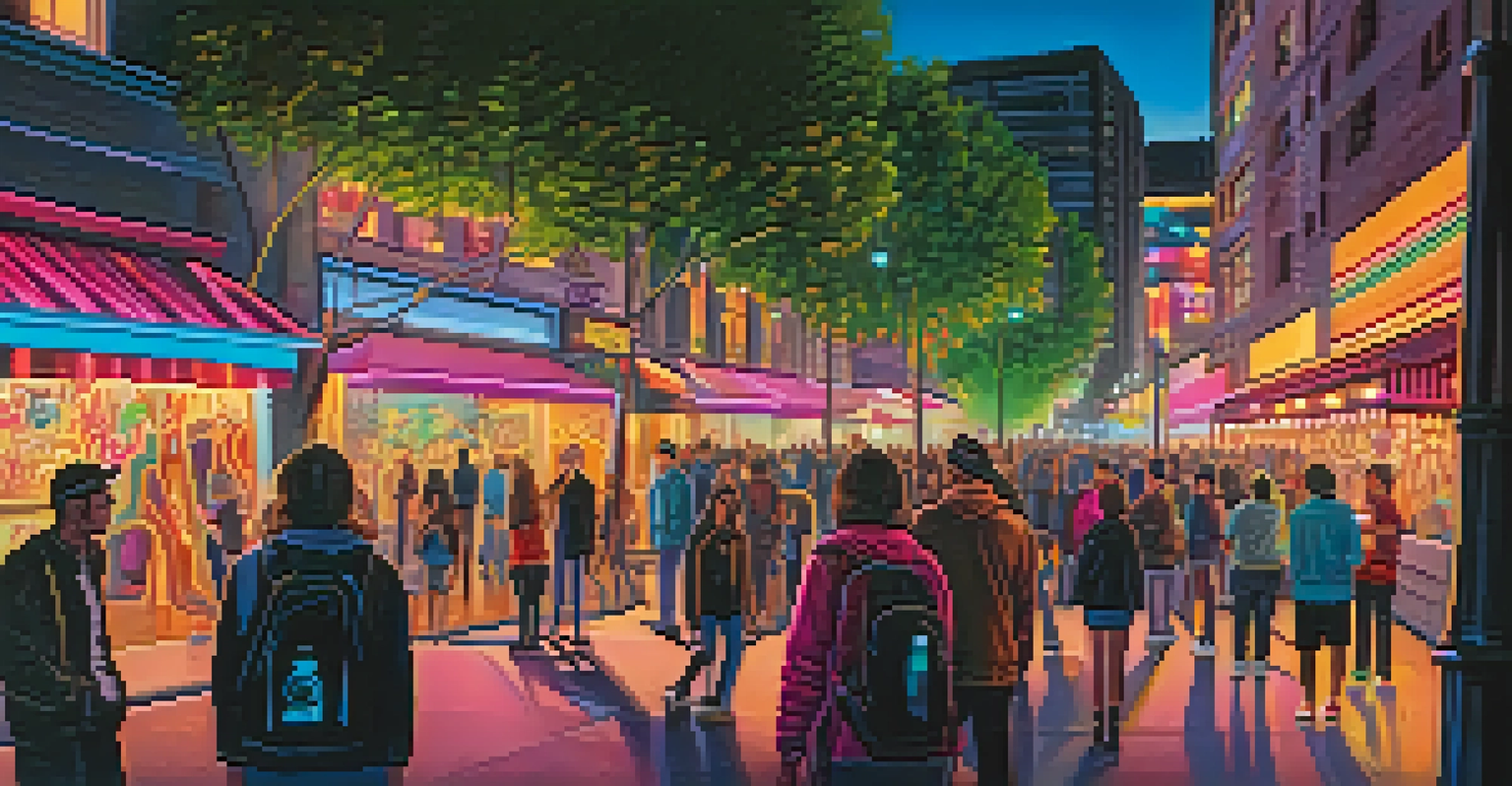Street Art as a Reflection of Urban Culture Today

Defining Street Art and Its Significance Today
Street art is more than just graffiti; it's a powerful medium for expression. It encompasses various forms, including murals, stencils, and installations, all of which contribute to urban aesthetics. In cities around the world, street art has become a vital part of the cultural and social landscape, reflecting the voices of diverse communities.
Art is not what you see, but what you make others see.
Today, street art serves as a canvas for artists to address pressing social issues, celebrate cultural identities, and showcase artistic talent. Unlike traditional art forms, which are often confined to galleries, street art invites everyone to engage with it in their everyday lives. This accessibility makes it a crucial part of urban culture.
Related Resource
As cities evolve, so does the message behind street art. It captures the pulse of urban life, highlighting themes like gentrification, social justice, and community pride. By reflecting these changing dynamics, street art becomes a visual diary of a city's journey through time.
The Role of Community in Street Art
Community involvement is at the heart of street art, shaping its direction and significance. Local artists often draw inspiration from their surroundings, creating pieces that resonate with their neighborhood's history and culture. This connection fosters a sense of belonging and pride among residents.

Street art projects frequently emerge from community initiatives, where artists collaborate with locals to beautify public spaces. These collaborations not only enhance the visual appeal of an area but also strengthen community bonds. When residents see their stories represented in art, it cultivates a shared identity.
Street Art as Community Expression
Street art reflects local culture and fosters community pride through collaborative projects that engage residents.
Moreover, street art can serve as a catalyst for dialogue within communities. It raises awareness about social issues and encourages conversations that may otherwise go unheard. In this way, street art becomes a tool for empowerment, giving a voice to marginalized communities.
Street Art as a Medium for Social Commentary
One of the most striking aspects of street art is its ability to comment on societal issues. Artists often use their work to challenge injustices, provoke thought, and inspire change. For instance, murals addressing climate change or racial inequality spark conversations that resonate with viewers long after they leave the site.
The role of the artist is to make the revolution irresistible.
This form of artistic expression can be powerful, as it often reaches an audience that traditional media may overlook. Street art places vital issues in public spaces, making them impossible to ignore. Its visibility encourages passersby to engage with the messages being conveyed.
Related Resource
Furthermore, street art's ephemeral nature adds to its impact. Many pieces are temporary, existing only for a short time before being painted over or weathered away. This transience can symbolize the urgency of the issues addressed, reminding us that social change is a continual process.
The Evolution of Street Art Styles
Street art has evolved significantly over the decades, influenced by various artistic movements and technologies. From the early days of tagging and simple graffiti, the style has morphed into complex murals and intricate stencils. This evolution reflects the growing sophistication and diversity of street artists worldwide.
Contemporary street artists often blend different styles, incorporating elements from pop culture, surrealism, and abstraction. This fusion creates a rich tapestry of visual language that speaks to a broad audience. As artists experiment with new techniques and materials, street art continues to push boundaries and redefine itself.
Social Commentary Through Art
Street art serves as a powerful medium for addressing social issues, provoking thought, and inspiring change in public spaces.
Moreover, the rise of social media has played a pivotal role in the evolution of street art. Platforms like Instagram allow artists to showcase their work to a global audience, garnering attention and inspiring others. This interconnectedness fuels innovation and encourages artists to explore new themes and styles.
The Impact of Technology on Street Art
Technology has transformed street art in remarkable ways, from the tools artists use to the platforms they share their work on. Spray paint and stencils have given way to digital tools, enabling artists to create intricate designs with precision. This shift allows for a new level of creativity and experimentation.
Moreover, technology has expanded the reach of street art. Artists can now document their work through photography and video, sharing their process and final pieces online. This visibility has led to increased recognition for street artists, elevating their status within the art community.
Related Resource
However, the digital age also presents challenges. With the rise of street art as a trend, some pieces may be commodified, losing their original meaning or context. It's essential for both artists and viewers to remain mindful of the intentions behind the artwork and to preserve its authenticity.
Street Art and Urban Revitalization
Street art has become a vital tool in urban revitalization efforts, breathing new life into neglected areas. Many cities have embraced street art as a way to attract tourists, enhance local economies, and promote community engagement. Vibrant murals can transform dull walls into captivating landmarks, drawing visitors and inspiring pride among residents.
By involving local artists in these projects, cities can ensure that the art reflects the unique characteristics of the neighborhood. This collaborative approach fosters a sense of ownership among residents, making them more likely to care for and protect the art. As a result, street art contributes to a revitalized sense of community.
Challenges of Street Artists Today
Street artists face legal hurdles and public misconceptions, which can threaten their ability to express themselves freely.
Additionally, street art can serve as a visual narrative of a city's history and culture. Murals can tell the stories of a community's struggles and triumphs, creating a deeper connection between residents and their environment. This storytelling aspect is vital for fostering pride and understanding in urban spaces.
Challenges Facing Street Artists Today
Despite its growing popularity, street art faces numerous challenges, including legal issues and public perception. Many street artists operate in a legal gray area, as their work is often considered vandalism by authorities. This can lead to fines or arrests, discouraging artists from expressing themselves in public spaces.
Additionally, some communities may resist street art, viewing it as an eyesore rather than a form of cultural expression. This perception can hinder the development of vibrant street art scenes in certain areas. It's crucial for artists and advocates to educate the public about the benefits of street art, promoting it as a legitimate art form.

Finally, as street art becomes more mainstream, there is a risk of commercialization. Some artists may struggle to maintain their authenticity and artistic vision amidst the pressure to create marketable pieces. Navigating this landscape requires a delicate balance between artistic integrity and the realities of the art market.